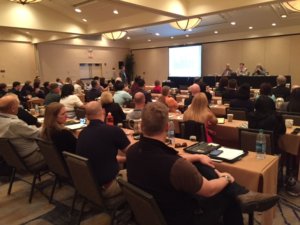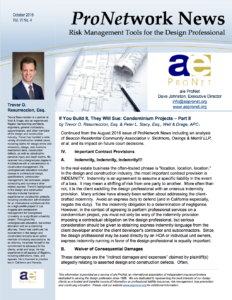 Copyright seems like a rather lofty notion. Few put copyright at the top of their list of must-haves in contract negotiations, and even fewer take the time to actually register their documents for copyright protection. But you do have copyright protections under current law. That copyright can come in handy as a risk management tool as well as leverage in a fee dispute. Unfortunately, many design professionals give away their rights vis-à-vis their contracts without a full appreciation of the implications of their actions.
Copyright seems like a rather lofty notion. Few put copyright at the top of their list of must-haves in contract negotiations, and even fewer take the time to actually register their documents for copyright protection. But you do have copyright protections under current law. That copyright can come in handy as a risk management tool as well as leverage in a fee dispute. Unfortunately, many design professionals give away their rights vis-à-vis their contracts without a full appreciation of the implications of their actions.
Copyright statutes have been on our books since the 1700s. The Copyright Act (Title 17 of the US Code) provides useful protection applicable to your practice by including pictorial, graphic and sculptural works, as well as architectural works, as copyrightable materials. Architectural works include drawings, models and the structure itself. “Arrangement of spaces and elements” are protected, but not “individual standard features.” Registering your architectural works creates a public record of the registration and is essential in an infringement action. It takes 30 minutes and $30 to complete. But even if you do not register your works, they are still protected unless you give those rights away by contract.
Copyright in Standard Design Contracts
Standard design industry contracts (e.g., AIA and EJCDC), keep the copyright with the design professional and provide for a limited license to the client/owner for use of the documents. That license is generally limited for use on the specific project only, and does not allow for transfer of that license to third parties. The design industry contracts also include an indemnity provision in the professional’s favor that mitigates risk should those documents be used or modified without proper authority. Most owner generated contracts, on the other hand, demand a transfer of copyright to the owner, and those terms are often agreed to by the professional, presumably because the professional is not fully aware of its rights or the risks involved in giving those rights away. Continue reading “Copyright Rights and Wrongs”

 At a panel for the NC Bar Association Construction Law Winter Meeting, attorney Melissa Brumback and her colleagues discussed insurance issues for design professionals. One hot topic was the way architects and engineers can inadvertently invalidate their insurance by agreeing to overly broad contractual language. Frequently, this has to do with the standard of care. Melissa penned the following post for the NC Construction Law Blog, and we have reposted it here with her permission:
At a panel for the NC Bar Association Construction Law Winter Meeting, attorney Melissa Brumback and her colleagues discussed insurance issues for design professionals. One hot topic was the way architects and engineers can inadvertently invalidate their insurance by agreeing to overly broad contractual language. Frequently, this has to do with the standard of care. Melissa penned the following post for the NC Construction Law Blog, and we have reposted it here with her permission:
 For the last few sunny days, a/e ProNet members from across the country have gathered in Scottsdale, Arizona for our annual Spring Meeting (March 1-3). a/e ProNet brokers are independent. Technically, we operate as competitors. Membership is by invitation only. We come together voluntarily as recognized leaders in our industry, meeting the insurance needs of architects and engineers. Our combined premium volume, experience, and national reach make our meetings an attractive target for insurance companies, premium finance companies, and other professionals. With our two annual meetings, we keep our fingers on the pulse of the insurance industry and advocate for our clients.
For the last few sunny days, a/e ProNet members from across the country have gathered in Scottsdale, Arizona for our annual Spring Meeting (March 1-3). a/e ProNet brokers are independent. Technically, we operate as competitors. Membership is by invitation only. We come together voluntarily as recognized leaders in our industry, meeting the insurance needs of architects and engineers. Our combined premium volume, experience, and national reach make our meetings an attractive target for insurance companies, premium finance companies, and other professionals. With our two annual meetings, we keep our fingers on the pulse of the insurance industry and advocate for our clients.

 Do architects owe a “duty of care” to the homeowners of a condominium project with whom the architects have no contractual privity? According to the California Supreme Court, they do. What does this mean in practical terms? The answer is that architects are now more than ever exposed to potential future claims and lawsuits brought by homeowners and the homeowners’ associations years after the project has been completed even where the architect’s design decisions are trumped by those of the project developer, and the architect’s role in the construction phase of the project is limited.
Do architects owe a “duty of care” to the homeowners of a condominium project with whom the architects have no contractual privity? According to the California Supreme Court, they do. What does this mean in practical terms? The answer is that architects are now more than ever exposed to potential future claims and lawsuits brought by homeowners and the homeowners’ associations years after the project has been completed even where the architect’s design decisions are trumped by those of the project developer, and the architect’s role in the construction phase of the project is limited.